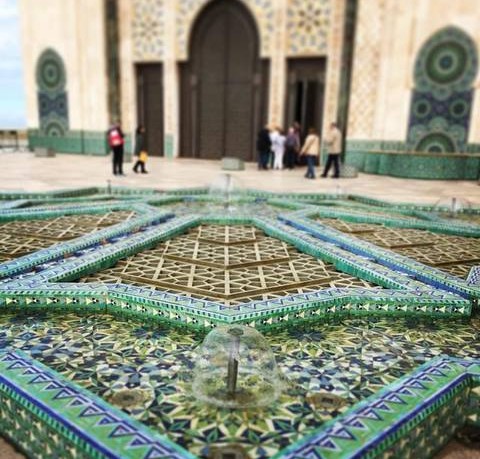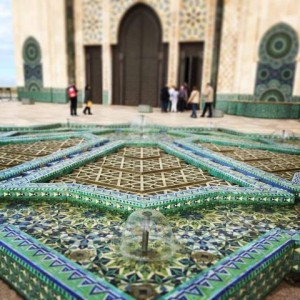Miami Herald
by Nancy San Martin
A fountain at Mosque Hassan, Casablanca — the largest in Morocco and Africa and one of the largest in the world.
CASABLANCA, MOROCCO
Like the rest of the world, this exotic kingdom in northwest Africa has been racing to catch up with the digital age. For media outlets, the race comes with government restrictions — and severe penalties for journalists who violate them — that are just now in the midst of an overhaul three years in the making.
At issue is how to regulate an industry that is constantly evolving in a region with long-held convictions where turmoil has spread as quickly as new media. The Arab Spring in 2011, for example, was a series of anti-government protests, uprisings and armed rebellions that spread across the Middle East, propelled in large part by calls to action posted on Twitter and Facebook. Today, new media also is being used by radical extremists to spread their own messages.
For Morocco, the effort to amend or remove existing laws tied to media as well as introduce new regulations specifically tied to digital media represents not just a cultural shift but also a political change for a constitutional monarchy where the King holds vast executive and legislative powers.
“There is no democracy without media and there is no media without online media and there is no online media without freedom,” said Minister of Communication Mustapha El Khalfi.
“We hope by the end of this year, it will be adopted by the government,” El Khalfi said.
Meanwhile, those working in the media industry are in the midst of their own transformation.
Many print outlets are in the early stages of digital editions and are finding themselves having to balance content with the values and beliefs not just of Moroccans but of Muslims in the diaspora whose experience and viewpoints are often vastly different.
Zineb Ibnouzahir Lahlou, editor of the region’s first magazine for women — Femmes Du Maroc, www.femmesdumaroc.com (Women of Morocco) — said the digital age has provided Muslim women abroad the ability to read content on issues they care about. But it also has presented a new challenge: providing edgy content on women’s issues while taking care not to offend.
The magazine, which now goes by the initials FDM, was founded not as a publication to be scanned while at the beauty salon but rather to provoke deep thought on subjects of concern for all women: balancing modernity, free thinking and traditional values.
“It was a little revolution,” Ibnouzahir Lahlou said of the early days of the publication. “Even if we are Muslim, we have a right not to practice. We want to talk to women who don’t feel free thinking that.”
Over the past 19 years, the magazine has become a symbol for women’s rights with thoughtful content and provocative covers, including that of a pregnant TV personality in the buff published in 2009. The image was similar to the Demi Moore cover published in Vanity Fair in 1991 that is still viewed as “scandalous” by some in the United States.
With its digital edition, the FDM now has the opportunity to reach Muslim readers around the world. But it has to tailor its content for those women in the diaspora who are struggling with their own sense of identity and backlash from terrorists acts that have tarnished the Islam religion.
“It’s difficult to know what women want,” Ibnouzahir said. “We are completely split between tradition and modernity. Women are the enemies of women because a lot of them will judge. The veiled ones will look at modern women in a very critical way, as if they are not respecting tradition, and the modern ones will look at the veiled ones just as critically.”
Civil society also is turning to new media to engage citizens.
In the capital city of Rabat, a young group of activists recently launched www.nouabook.ma, an online platform to connect citizens with their representatives in Parliament. The platform, which is linked to Facebook, Twitter and Google +, is making strides since it’s official launch in October with some 50 to 100 visitors per day, 190 questions submitted by citizens and 25 members of Parliament providing responses. Growth potential is huge and the group has ideas for enhancing engagement options (such as video, Google hangouts and infographics).
In Tangier, popular TV news outlet Medi1TV launched its digital edition five years ago and is experiencing growing pains similar to those by many U.S. news outlets. The digital team currently is detached from the TV newsroom, relying heavily on aggregation even as they try to produce unique content as often as possible. With a team of eight people (only two of which are experienced journalists), that is not an easy task. Their biggest challenge: getting buy-in from the journalists on the news side who don’t take the digital edition seriously enough to contribute.
Meanwhile, Medias24, which also was created five years ago and re-launched two years ago as a digital product that focuses primarily on business and domestic politics, has a team of 15 staffers comprised of former print reporters and digital journalists. Senior staffer Jamal Amiar, former print reporter and journalism professor, said it’s difficult to unlock the economic potential of digital media because of the sheer volume of competition in the fast-paced digital age, the fact that content has been free for so long few outlets have figured out how to make it profitable and an audience that is difficult to corral.
Amiar’s words of wisdom: “If you go back to the basics of media economics, if you want to make money you have to have an audience. If you want an audience, you have to deliver the right product.” The challenge, he said, is defining an audience and figuring out what that right product is.
Among the early successes of new media is Hit Radio, a nationally broadcast music station that also dabbles in hot topics. The station is at the top of Morocco’s radio sphere and is broadening it’s reach.
Launched in 2006, the radio station was the first to broadcast in the Moroccan language (as opposed to French or Arabic) and attracts a diverse young audience. It plays “hit” songs, including Moroccan rap and modern music. Hit Radio can be heard on more than 70 frequencies across the nation and half a dozen other countries. The station also offers content online and on mobile and is active on social media.
The station has 2 million fans on Facebook and more than 300,000 followers on Twitter.
According to one of the founders of Morocco’s first online digital media, www.Hespress.com, the keys to success in the digital world:
“You need good content,” said Hassane El Guennouni, CEO and co-founder. “And you need to speak to everyone.”
Audience engagement in the form of commenting has been a valuable contributor to its growth. And Hespress discovered early on how to monetize the website before heavy competition got in the way.
“The source of revenue was Google,” he said. “Google will pay as much as you have visitors.”
The Arabic-only website was launched seven years ago and has grown to become one of the top sites in the MENA [Middle East and North Africa] region with 20 journalists on staff who produce daily content — from news to entertainment (80 percent of which is focused on Morocco).
The content is offered on various platforms, including desktop, mobile, tablet and smart TV. They receive more than 7.5 million unique visitors per month, have 4 million fans on Facebook and more than 300,000 followers on Twitter. The audience is comprised primarily of young professionals and revenue is dependent on advertising.
As the audience continues to grow and move toward mobile, Hespress is thinking ahead with plans to launch a French edition targeted at second generation Moroccans living abroad. The goal: to become the top site in the MENA region.
The site’s success online comes a few years after it tried to publish a print magazine but gave up because it wasn’t economically viable.
“Offline is very expensive,” El Guennouni said. “We couldn’t find a business model that worked.”
San Martin visited digital media institutions in Morocco through an exchange program managed by the International Center for Journalists and funded by the U.S. State Department’s Professional Fellows Program.
NSANMARTIN@MIAMIHERALD.COM








